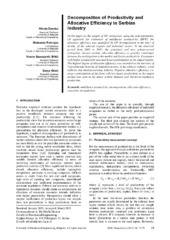Приказ основних података о документу
Dekompozicija produktivnosti i alokativna efikasnost u industriji Srbije
Decomposition of productivity and allocative efficiency in Serbian industry
| dc.creator | Dondur, Nikola | |
| dc.creator | Pokrajac, Slobodan | |
| dc.creator | Spasojević Brkić, Vesna | |
| dc.creator | Grbić, Sonja | |
| dc.date.accessioned | 2022-09-19T16:43:48Z | |
| dc.date.available | 2022-09-19T16:43:48Z | |
| dc.date.issued | 2011 | |
| dc.identifier.issn | 1451-2092 | |
| dc.identifier.uri | https://machinery.mas.bg.ac.rs/handle/123456789/1296 | |
| dc.description.abstract | Na uzorku od 567 preduzeća koristeći poluparametrijski LP pristup određivanja multifaktorske produktivnosti (MFP) u radu je OP dekompozicijom kvantifikovana alokativna efikasnost na nivou Srbije, izabranih regiona i industrijskih sektora. U posmatranom periodu 2005 - 2007 privatizovana i nova privatna preduzeća pokazala su pozitivnu alokativnu efikasnost odnosno pozitivnu kovarijaciju učešća na tržištu i faktorske produktivnosti. Preduzeća sa većom produktivnošću su imala i veća učešća na tržištu autputa. Najveća alokativna efikasnost je zabeležena na području Vojvodine, a od industrijskih sektora u industriji duvana, drvnoj industriji i industriji prerade metala. Negativna alokativna efikasnost odnosno veće učešće na tržištu autputa firmi sa niskom faktorskom produktivnošću utvrđena je u industriji motornih vozila i proizvodnji električnih mašina. | sr |
| dc.description.abstract | In this paper on the sample of 567 enterprises, using the semi-parametric LP approach for estimation of multifactor productivity (MFP), the allocative efficiency was quantified by OP decomposition at the level of Serbia, of the selected regions and industrial sectors. In the observed period from 2005 to 2007, the privatised and new private-owned enterprises showed positive allocative efficiency or positive covariance between the participation in the market and factor productivity. Companies with higher productivity also had larger participation in the output market. The highest degree of allocative efficiency was recorded on the territory of Vojvodina and in terms of industrial sectors, in the tobacco industry, wood industry and metal-processing industry. Negative allocative efficiency, i.e. larger participation of the firms with low factor productivity in the output market was seen in the motor vehicle industry and electrical machinery production. | en |
| dc.publisher | Univerzitet u Beogradu - Mašinski fakultet, Beograd | |
| dc.rights | openAccess | |
| dc.rights.uri | https://creativecommons.org/licenses/by/4.0/ | |
| dc.source | FME Transactions | |
| dc.subject | transition | en |
| dc.subject | multifactor productivity | en |
| dc.subject | deregulation | en |
| dc.subject | decomposition | en |
| dc.subject | allocative efficiency | en |
| dc.title | Dekompozicija produktivnosti i alokativna efikasnost u industriji Srbije | sr |
| dc.title | Decomposition of productivity and allocative efficiency in Serbian industry | en |
| dc.type | article | |
| dc.rights.license | BY | |
| dc.citation.epage | 78 | |
| dc.citation.issue | 2 | |
| dc.citation.other | 39(2): 73-78 | |
| dc.citation.rank | M51 | |
| dc.citation.spage | 73 | |
| dc.citation.volume | 39 | |
| dc.identifier.fulltext | http://machinery.mas.bg.ac.rs/bitstream/id/250/1293.pdf | |
| dc.identifier.rcub | https://hdl.handle.net/21.15107/rcub_machinery_1296 | |
| dc.identifier.scopus | 2-s2.0-84859509800 | |
| dc.type.version | publishedVersion |


